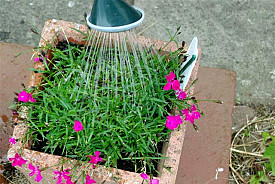How, When and Where to Water Potted Plants
 Potted plants are a beautiful green presence that enhances the environment of your home and garden. Help your container plant collection thrive by learning how, when, and where to water to achieve the healthiest, happiest results.
Potted plants are a beautiful green presence that enhances the environment of your home and garden. Help your container plant collection thrive by learning how, when, and where to water to achieve the healthiest, happiest results.
How and When to Water
Identify your plants to get a general idea of their watering and general care requirements. However, don't rely on a strict schedule for your "babies." You'll be a much more successful gardener if you trust your senses -- examining the potting mixture to see whether it looks dry, hefting the plants and touching their soil, even smelling them to find out whether they are developing the rank odor that indicates they are waterlogged.
One advantage of container plants over those in garden beds is that you can easily lift them up to get an idea of how heavy they should feel before and after watering. Another traditional method of checking the moisture level is poking your finger (gently) into the soil; while its surface may be dry to the touch, you might feel damp soil an inch or so below. A moisture meter is a quick and accurate way to monitor, particularly useful with large plants that can't be lifted.
Slow, deep watering gives the best results. The optimal time is early morning, before 10 am in winter, 9 am or earlier in summer or an especially hot locale).
Where to Water
Focus on soaking your plants' roots, rather than wetting their leaves or flowers. Some smooth-leaved tropical species, such as begonia, do enjoy a regular light spritzing of their foliage, with occasional wipe-downs of their leaves to remove dust; however, cactuses, fuzzy-leaved plants like African violets, and succulents do not. Misting any plant outdoors in bright sunshine is a bad idea and can lead to parched leaves.
Drainage
Container plants need a way for excess water to drain from their soil. Make sure purchased or homemade planters have proper drainage -- 3/8 to 1/2" holes in the bottom, approximately five per square foot. If the holes in a plastic pot are insufficient or non-existent, you can use a sharp object (my go-to tool is a metal shish kebab skewer) to add to them. Drill ceramic containers with a masonry bit. A simpler way to use a pretty pot that does not offer enough drainage is by turning it into a cache-pot that hides a more utilitarian container inside. Once your plant is established, check the drainage holes from time to time to ensure they are not blocked. When the roots begin to protrude, it is time to repot.
Signs of Overwatering
An obvious signal that you are overwatering a potted plant is standing water in its saucer. Another way to tell is by checking for brown, mushy roots emerging from the underside of the container. These indicate the plant is suffering from root rot. Other tell-tale signs are yellowish edges or brownish patches on the foliage, young leaves falling, and a general failure to grow.
Deal with a mild problem by draining any excess water from both the pot and the saucer and avoiding watering until the top inch or two of soil has dried out. For a more serious case, gently remove the plant from its soil, trim off dead or rotten roots, and replant in a clean container with pasteurized potting mix.
Signs of Underwatering
A plant that is starved of water will not grow new leaves. The appearance of its existing leaves will undergo a gradual change from translucent, to curled and yellow, and finally to brown and parched. At the same time, you might notice the soil shrinking away from the sides of the container, like a fully baked cake.
Remedy a mild case of dehydration by giving the plant a drink. In addition, you might want to place its pot in a larger, shallow container of water for about 10 minutes. Severe underwatering is best dealt with by repotting your plant in a slightly larger container with a fresh supply of growing medium.
Laura Firszt writes for networx.com.
Looking for a Pro? Call us (866) 441-6648

Landscaping Average Costs
Landscapers Experiences

Landscaping Turns A Weed Patch Into A Great Little Zen Garden

Concrete Patio Is The Finishing Touch For An Artist's Studio



